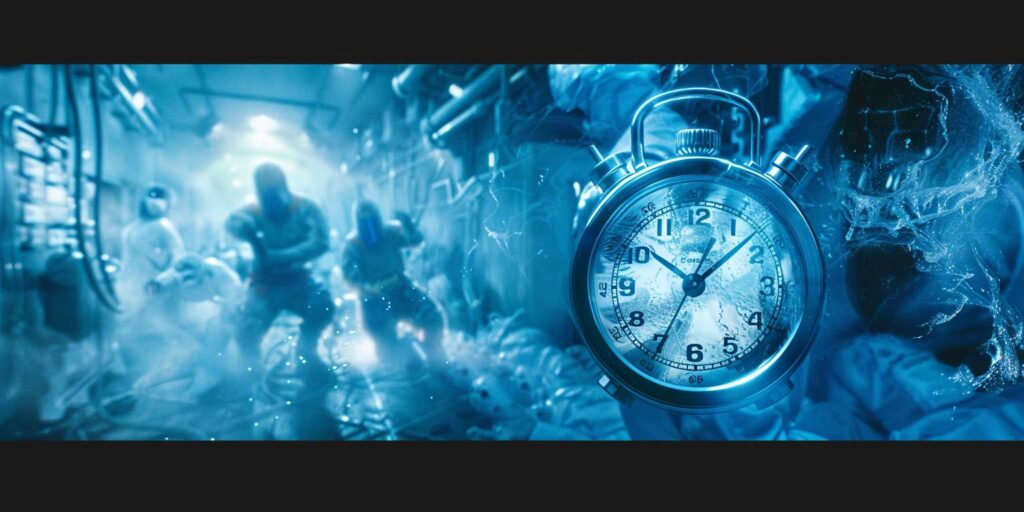
One of the greatest threats to successful cryopreservation isn’t damage from freezing—it’s ischemia: the cellular and structural deterioration caused by the lack of oxygen and blood flow after the heart stops. Within minutes of cardiac arrest, neurons begin to die, and the brain’s delicate architecture begins to break down. Every minute counts.
For decades, cryonicists have been taught that after “actual death” we must wait for “legal death” to be declared before any procedures—like chest compressions or external body cooling—can begin. But this delay, even when brief, adds critical ischemic injury that may limit or even preclude eventual revival.
What if we told you that this delay is not required by law?
Death ≠ Medical Inaction
In Michigan (and in many other states), there is no law that prohibits Cardiopulmonary Rescuscitation (CPR) or oxygenation from beginning at the moment of cardiac arrest, so long as the patient has provided prior informed consent. These actions—especially when clearly documented—are legally permissible as part of the patient’s post-mortem care plan.
Under Michigan law:
“Death means the irreversible cessation of circulatory and respiratory functions… A determination of death must be made in accordance with accepted medical standards.”¹
This means a person is legally dead when a qualified medical professional pronounces them so. But the law is silent on what laypersons may do in the brief window between actual death and legal death. Importantly, chest compressions and oxygenation do not violate any statute when done with patient authorization—and do not require formal pronouncement to begin.
Furthermore, Michigan’s Public Health Code and Good Samaritan laws protect individuals, including laypersons, who act in good faith during an emergency:
“An individual… who in good faith renders emergency care at the scene of an emergency shall not be liable for civil damages… unless the conduct constitutes gross negligence or willful misconduct.”²
The implication: if you authorize such care in advance, a layperson’s effort to initiate CPR or cooling for the purpose of cryopreservation is not only legal—it is protected.
The Cooling Issue
In Michigan, external body cooling—such as ice application or cold water immersion—is generally delayed until after legal death is pronounced. This is because cooling is more visibly “post-mortem” and may be misinterpreted as interfering with emergency care or prematurely declaring death. Initiating external cooling before such a pronouncement could create legal ambiguity or risk accusations of premature post-mortem action. By delaying cooling until legal death, we remain fully compliant with state law and medical norms while still preserving the ability to act within seconds of pronouncement to reduce ischemic injury.
The Cryonics-Specific Opportunity
Cryonicists also have the ability to legally authorize immediate layperson action at the moment of cardiac arrest by including targeted provisions in their end-of-life documents. These include:
- – Power of Attorney for Health Care (POA-HC)
- – Living Will / Advance Directive
- – Physician Orders for Life Sustaining Treatment (POLST)
- – Examples of cryonics-specific forms: https://stevelebel.com/cryonics-documents
Sample language you can include:
“In the event of my cardiac arrest or cessation of spontaneous respiration, I authorize any person present—whether medically trained or not—to initiate non-resuscitative chest compressions and oxygenation for the sole purpose of preserving tissue viability. These actions may begin prior to the formal pronouncement of legal death and are not intended to revive me. I further authorize any person present to initiate external body cooling (e.g., application of ice packs or cold water) immediately after legal death has been declared by a licensed medical professional. These measures are part of my cryonics preservation plan, and I expressly waive any requirement that such interventions be delayed pending legal pronouncement.”
Why This Changes Everything
Cryonicists have long accepted a troubling reality: that ischemia during the gap between cardiac arrest and cryonics stabilization is inevitable. But it’s not. With proper documentation and planning, we can authorize CPR and cooling to begin within seconds—preserving precious brain structure and reducing cryoprotectant diffusion barriers later.
Practical Benefits:
- – Hospice-compatible
- – Legally sound
- – Layperson-activated
This is the beginning of a new standard in cryonics. It requires no new legislation—only new awareness, courage, and preparation.
Practical Examples
This interpretation offers multiple opportunities. Hospice staff, emergency standby providers, and even family and/or laypersons can take immediate steps to aid your successful cryopreservation. It opens the door to prepare our homes with CPR equipment and cooling blankets so family members can begin our preservation immediately.
Take Action Now
Cryonicists should not wait to make these changes. Update your documents now. Involve your healthcare surrogate. Inform your family and hospice. Give your standby team the legal foundation they need to act—without hesitation, without fear.
Every minute matters. And now, we can finally do something about it.
────────────────────────────────────────────
Footnotes & Legal References
1. Michigan Uniform Determination of Death Act (UDDA), MCL § 333.1033.
2. Michigan Good Samaritan Law, MCL § 333.20965.
Additional reading:
– Michigan Public Health Code: Act 368 of 1978.
– Hospice & palliative care standards: National Hospice and Palliative Care Organization (NHPCO).
– Cryonics Institute:
────────────────────────────────────────────
About the Author
Steve LeBel is a retired hospital CEO and an advocate for cryonics preparedness and planning. He is signed up with the Cryonics Institute and works to bridge the gap between end-of-life care and timely cryopreservation.
Email: Steve@SteveLeBel.com
Website: https://SteveLeBel.com
────────────────────────────────────────────